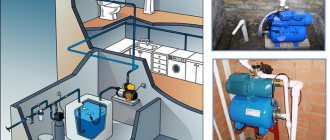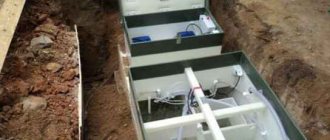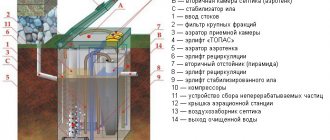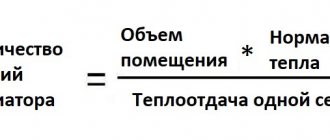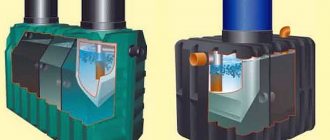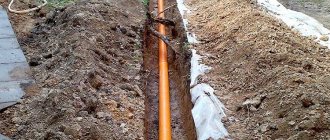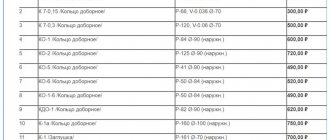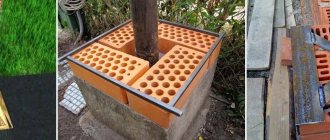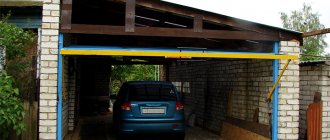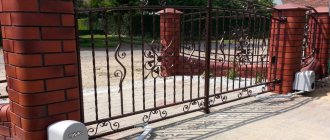About the manufacturer
is one of the largest Russian manufacturers of septic tanks and other plastic products.
The vast experience of the company’s employees and partners allows us to manufacture, deliver and install treatment plants throughout the country in the shortest possible time. Thanks to the high quality of manufacturing and installation, the availability of warranty and post-warranty service, Triton Plastic customers do not have to worry about any problems regarding wastewater disposal and treatment.
General characteristics and typical diagram
The design of a septic tank tank in general form, regardless of modification, can be represented as follows.
The body is made of plastic by casting with a wall thickness of up to 15 mm, making the surface monolithic and airtight. To increase the strength of the structure and improve resistance to deformation from soil shear, the body is reinforced with stiffeners - in these places the thickness of the walls of the “Tanks” reaches 17 mm.
The housing contains inlet and outlet pipes connecting sections of the sewer system. Through the inlet pipe, sewage flows into the tank, through the outlet pipe, the liquid goes into the filtration field or into the infiltrator for subsequent purification.
Also a necessary structural element of the “Tanks” is the neck, the main functional purpose of which is to pump out the resulting bottom sludge using sewage disposal equipment. During normal operating mode, to protect against debris and precipitation, the neck is closed with a hatch.
Depending on the modification, the inside of the housing is divided into two or three cleaning chambers; a modular-block design is used to regulate the installation’s performance. By means of membranes, partitions, filters and biogranules, 2- or 3-stage purification of incoming wastewater is carried out: mechanical, chemical and biological.
The partitions have overflows: when one compartment is filled to a certain height, water flows into another compartment for subsequent cleaning. To catch particles suspended in liquid, filters are installed in the partitions.
Septic tanks for cottages and houses of the “Tank” series are necessarily equipped with an aeration pipe for the biofilter and a ventilation pipe designed to remove accumulated gases. The ventilation pipe is equipped with a valve that opens when excess pressure is created inside the container
The diagram common to each of the Tank septic tank models is shown in the figure.
General layout of septic tanks Tank
Principle of operation
How does a septic tank work? The scheme for each of the models in the series is practically the same.
The operating principle of the septic tank tank is as follows.
The wastewater entering the treatment plant, along with suspended solids and feces, enters the primary settling tank through a pipeline and inlet pipe.
Next, you need to consider in detail how the sections of the device work.
In the first chamber, the liquid undergoes primary purification and processing by bacteria. The process is accompanied by the formation of steam, heat and gas, which is removed through the ventilation pipe. The smell of sewage near the installation should not be felt, since during normal operation it is neutralized by bacteria enclosed in granules.
Heavier solid particles in the liquid, under the influence of gravity, settle at the bottom of the first compartment, forming mineral sludge. The settled water, having risen to a certain level, gradually flows through the overflow into the second section.
Sewage that has undergone primary treatment (so-called “gray water”) continues to be purified in the second chamber. It also causes suspended liquid particles to sink to the bottom to form sludge. Next, the already clarified water goes through the overflow filter either to the outlet pipe and then to the post-treatment facility (infiltrator, storage or filtration well), or to the third compartment (if one is structurally provided in the model).
The conclusion that can be drawn by studying the stages of operation of Tank septic tanks is simple: the features of some aspects of cleaning and post-treatment depend on the installation model itself, as well as the wishes and requests of the owners.
It should be noted that the simpler the cleaning process, the less purified the water comes out of the device. In order to achieve a degree of water purification that meets the requirements of SNiP 2.04.03-85 (at least 95%), the installation of infiltrators is required, the number of which depends on the water-absorbing characteristics of the soil on the site.
Despite the fact that the general operating principle of Tank septic tanks is the same, the differences between the models are as follows:
- body volume;
- number of cleaning compartments;
- cleaning efficiency;
- the need for pumping with a sewage disposal machine.
Operating principle
It is worth talking about the principle of operation of the “Tank” septic tank in more detail.
The main part is divided into 3 chambers, which are connected by pipes for free flow of liquid. In the first chamber, domestic wastewater settles. Here they are separated into organic and inorganic waste. The former pass into the second chamber, the latter precipitate.
Special bacteria that process organic particles are responsible for the biological filtration process. As a result of their vital activity, .
Photo. Operating principle and main functional elements of the “Tank” septic tank with subsequent post-treatment in underground filtration fields
They claim that
the biological filter installed in the 3rd chamber ensures wastewater purity up to 70%.
The percentage, of course, is conditional; it needs to be set in the range from 50 to 70. Of course, such water cannot be pure; it must be further purified. For this purpose, another “chamber” is provided, connected to the main tank by a pipeline. It is called an infiltrator and is installed on a gravel bed (its price is about 3,500 rubles, sometimes about 4 of them are required, in addition you need to pay for soil development, several machines of crushed stone, sand - all this can cost about 80 thousand rubles in addition to the price of the septic tank itself " Tank").
The principle of operation of the “Tank” is based on the independent transfer of water from one chamber to another
under the influence of newly incoming water. At the same time, many questions arise during a volley discharge of water. The manufacturer claims that even with a large volume of incoming wastewater, some of it can be stored in the infiltrator.
Photo. Connection of several infiltrators to one septic tank “Tank”
However, the principle of gravity distribution of liquid forces you to very competently calculate the volume of the septic tank and take it with a reserve, overpaying for the volume. The same septic tank "Tver", for example, is devoid of such a drawback. You can choose the appropriate option by approximately calculating the volume of waste:
Unfortunately, the design does not provide for heating the septic tank in winter. This is why it can easily freeze in winter if used intermittently.
ATTENTION!
When the groundwater level is high, underground filtration fields in a septic tank made of concrete rings without filters and infiltrators cannot perform their function
, since they are all located under a high layer of groundwater.
One of the significant disadvantages of the Tank sewage system is silting of the outlet pipe, infiltrators and pipes. Already in the third year, the sticky mass completely covers the communications, and water stops flowing out of the container into the soil. Customers will have to dismantle the infiltration trenches, re-purchase materials and install them again. This will probably happen every 3 years.
Models and their main differences
The Tank line of septic tanks for cottages and homes includes five modifications, differing in working volumes and used to create comfortable living conditions for 1-9 people permanently residing in a house without a central sewerage system.
When selecting a septic tank model, you should mainly focus on the main indicator - the working volume.
The table shows the main characteristics of the models of cleaning devices in the “Tank” line.
| Model | Number of residents | Dimensions, mm | Volume, l | Productivity, l/day | Weight, kg |
| Tank-1 | 1-3 | 1200x1000x1700 | 1200 | 600 | 75 |
| Tank-2 | 3-4 | 1800x1200x1700 | 2000 | 800 | 130 |
| Tank-2.5 | 4-5 | 2030x1200x1850 | 2500 | 1000 | 140 |
| Tank-3 | 5-6 | 2200x1200x2000 | 3000 | 1200 | 150 |
| Tank-4 | 7-9 | 3600x1000x1700 | 3600 | 1800 | 225 |
Before making a choice in favor of one model or another, you need to make sure whether the installation’s performance will be sufficient to clean all the waste generated in the house.
According to SNiP 2.04.01-85*, the standard for waste disposal is 200 l/day for each resident. Thus, to correctly select the Tank septic tank model, it is important to accurately determine the daily water consumption by multiplying the consumption rate by the number of people who will constantly use the sewer.
Tank-1
Septic tank for a summer residence The tank of the first model is distinguished by its miniature size - other representatives of the series do not have such modest dimensions as it. The device can also be used for a small house with permanent residence of 1-3 people. Read more about Tank-1 in this article.
The installation is capable of providing daily purification of 600 liters of water. The model is reliable and practical, does not cause any problems during installation and operation.
Appearance of the Tank-1 model
Tank-2
The second, three-chamber model of the “Tank” series of septic tanks, is distinguished by a larger working volume and, accordingly, greater productivity (up to 800 l/day) compared to the first. Tank-2 is suitable for installation not only for small private and country houses, but also for a full-fledged home for a family of 3-4 people.
Relatively small dimensions and weight allow installation by hand, without the use of lifting equipment. You can find out more about the Tank-2 septic tank here.
Appearance of the Tank-2 model
Tank-2.5
Septic tanks Tank-2.5 have gained popularity primarily due to the optimal ratio of low cost and increased productivity, combined with modest dimensions. Many satisfied users leave mostly positive reviews about the system's reliability and cleaning efficiency.
The non-volatile installation is capable of ensuring uninterrupted wastewater treatment even with burst emissions. All details about Tank-2.5 septic tanks can be found in this article.
Tank-3
The Tank-3 treatment plant, which is one of the most high-performance systems of the Tank series, is capable of processing about 1200 liters of wastewater per day. Despite its far from modest dimensions, the device is easy to install and is not demanding in terms of operating conditions.
Tank-3 is equally suitable for a spacious house for 5-6 people, as well as for small cafes, hotels, private baths and saunas. More detailed information about Tank-3 septic tanks can be found here.
Tank-4
Septic tank Tank-4 is the largest of all representatives of its line. Impressive dimensions and significant working volume are successfully combined with high performance and an affordable price. Choosing this model is the most rational solution for owners of estates with permanent residence for a large family of 7-9 people.
Septic tank Tank-4 is a container with a volume of 3.6 m3 and dimensions of 3.8x1.0x1.7 m, made of environmentally friendly polyethylene. To increase rigidity and resistance to deformation from soil influence, the walls of the device are equipped with stiffeners, the thickness of the plastic is 17 mm. For maintenance and improved manufacturability, the model is equipped with three necks with hatches.
The layout of the septic tank Tank of the fourth model is practically no different from the design of other three-chamber treatment devices in the series. The chambers are separated by partitions with overflows, through which the water goes through the next stage of purification.
The operating principle of the Tank 4 septic tank is identical to similar models. In the first section, sewage water is received from the inlet pipe. It performs the primary separation of suspended matter into heavy and light fractions: the former sink to the bottom and form sludge, and the latter flow through overflows along with settled water into the next sections, in which they are further processed. The final treatment of wastewater before it enters the ground is carried out using the soil tertiary treatment method.
Septic tanks Tank-4 have a number of advantages:
- simplicity and reliability of design;
- low probability of clogging - anaerobic bacteria are able to process even foreign objects and debris that accidentally get inside - leftover toilet paper, food products, etc.;
- energy independence;
- relatively low installation costs;
- the ability to install additional infiltrators, thanks to which the septic tank can be installed on any soil;
- ease and simplicity of maintenance - cleaning is allowed approximately once a year.
Septic tank Tank-4
Flaws
The process of building a septic tank includes the main points: digging a pit, reinforcing and concreting the walls of the septic tank, installing and concreting the roof of the septic tank.
- The need for system maintenance and monitoring. About once a year you need to completely remove the sediment that accumulates at the bottom of the septic tank. This is done using special sewer equipment. The cost of work is higher the further from the city limits your site is located. To allow more time between cleanings, you can use special additives for the septic tank. The volume of precipitation will be less, but the cost of these additives depends on their effectiveness. In any case, to maintain a septic tank, you will periodically need to shell out a lot of money.
- Carrying out preparatory work related to the installation of a septic tank. To install this type of sewer, you will need a deep hole, and extracting such a volume of earth is quite a difficult job. Such work will require a lot of time and physical effort. This issue can be resolved with the help of hired equipment that will do all the work. In this case, additional expenses will arise, in addition, this equipment will need to provide unhindered access to the future location of the septic tank, which can sometimes be problematic.
- Before starting excavation work, it is necessary to find out about the depth of groundwater in the area. If it is small and the water comes close to the surface, then special measures must be taken to strengthen the walls of the pit. Otherwise, when the groundwater level rises in the spring or during prolonged and heavy rainfall, the septic tank will simply float and rise to the surface. In this case, there will be additional costs for repairing the incoming and outgoing pipes. Also, clay soils and high groundwater levels can make it difficult for purified water to flow into the ground. The septic tank may overflow, therefore, additional cleaning work will be needed.
- Since no chemical additives are used in the wastewater treatment process, unpleasant odors may increase as a result of the operation of the plant.
General installation principles
Installation of treatment facilities of the “Tank” series is not difficult and can be done either independently or with the involvement of third-party labor. In particular, for the Tank-3 and Tank-4 models, due to their considerable dimensions and impressive weight, the use of lifting equipment may be required. As for excavation work, it all depends on the chosen model: the larger the volume of the treatment plant, the larger the pit will need to be dug.
The main installation steps are as follows:
- digging a pit for a container and filling a cushion of sand;
- digging trenches for inlet, connecting and outlet pipes;
- lowering the septic tank;
- filling the pit with a cement-sand mixture;
- installation of an infiltrator;
- pipe connection.
The technology for mounting “Tanks” with photos and videos is discussed in detail here.
Photo: septic tank Tank installed in a pit
Installing a septic tank “Tank” with your own hands
The installation instructions for the treatment plant will allow you to quickly and efficiently install a septic tank near a private house. As a result, it will be possible to organize an effective autonomous sewerage system. The installation process is carried out sequentially and consists of several stages.
Preparatory work
At the initial stage, you need to prepare materials and tools for installing a septic tank. It is also necessary to take a responsible approach to choosing the location for installing the treatment structure. Despite its high tightness and strength, the container can cause harm to nature. After all, it is impossible to exclude the leakage of sewage through loose connections or as a result of damage to both the septic tank body and sewer pipelines. To comply with current sanitary standards, it is necessary to locate a treatment facility taking into account the following rules:
- The septic tank is dug into the ground from the water intake at a distance of 20 to 50 m. Removal depends on the type of soil. In this case, the distance to the water supply pipeline should be 10 m. This will avoid the possibility of contamination of drinking water if an emergency occurs.
- The minimum distance to a private house from the installation site of the septic tank should be 5 m. This will prevent the base of the building from being washed away by filtered water, which is absorbed by the soil. In this case, the maximum distance to a residential building should be 15 m. Otherwise, difficulties will arise in creating the required slope for the sewer pipeline from a private house, thanks to which the wastewater moves by gravity to the treatment plant.
- There is a free passage to the place where the septic tank is installed, because the device needs to be cleaned periodically.
- The treatment facility should not be located close to the fence of a private area. The septic tank is dug in at a distance of 2 m from the fence. The same distance must be maintained from the passage between sites. In this case, the distance to a public road must be 5 m.
- The “Tank” septic tank must be installed 5 m from the gas pipeline.
- The installation of the treatment plant is carried out 3 m from trees and 1 m from bushes.
Observing all distances, marking of private territory is carried out. As a result, it will be possible to correctly determine the exact location where the “Tank” septic tank will be installed and the sewer pipelines will be laid. When marking the site, it is also necessary to take into account the terrain. Elements of autonomous sewage systems must be located down the slope of the territory relative to the water source.
Advice! It is advisable to lay the pipe from a dacha or cottage in a straight line. This will reduce the likelihood of clogging, because the accumulation of solid sewage elements occurs in the bends of the pipeline. If, however, the installation of the sewer pipe cannot be done in a straight line, then in places where it changes direction, inspection wells are installed. They will allow you to clean the pipeline.
During preparatory work, the depth of groundwater in private territory is determined. You also need to know the type of sedimentary rocks. This will allow you to determine the depth of the pit for the septic tank.
Installation of the treatment plant is carried out using the following materials:
- sand;
- crushed stone;
- cement;
- polymer construction mesh;
- heat insulator;
- geotextiles.
If the groundwater in a private area is shallow, then you need to prepare a concrete slab or cement-sand mortar to strengthen the septic tank. This will eliminate the possibility of the treatment plant being pushed out of the soil.
Land works
First, a pit is dug for a septic tank. The dimensions of the pit must exceed the dimensions of the treatment plant by 250-300 mm. When determining the depth of the pit, you need to take into account the following nuances:
- equipment height;
- sand cushion thickness;
- the required slope of the sewer pipe from a private house;
- the need for a screed made of concrete mortar.
The septic tank must be buried in the soil so that the treatment plant can be insulated. However, the distance from the top of the device to the ground surface should not be more than 1 m.
A sand cushion at the bottom of the pit is created with a thickness of 300-400 mm. During the process, it is compacted and leveled so that the septic tank is positioned strictly horizontally. A geotextile is laid between the sand and the ground. When the groundwater is high, then a concrete slab is installed on top of the sand bed. You can also make a screed. In this case, it is necessary to provide for the presence of metal loops in the concrete. Eye bolts can be used instead. The distance between anchors or hinges should be greater than the size of the septic tank.
The hole for the infiltrator is dug from the main treatment plant at a distance of 2 m. The dimensions of the pit should be 500 mm larger on each side than the dimensions of the tank. It is also necessary to take into account the number of installed containers.
The bottom of the prepared pit is covered with a construction polymer mesh, which is filled with a mixture of crushed stone and sand. In this case, the walls of the pit are covered with geotextiles.
An external sewer pipeline from a private house is laid in a trench. Its width should be 200 mm greater than the diameter of the pipe on each side. At the bottom of the trench, a sand cushion with a thickness of 100 to 200 mm is created. There is no need to compact the sandy base too much.
Installation of a “Tank” septic tank and infiltrator
Relatively large and heavy equipment is mounted using a crane. All tanks must be installed without distortion. Installation of lightweight devices can be carried out using ropes. In this case, the work is performed by three people.
Although the septic tank designer has created a design that does not float when the groundwater level rises, it is still recommended to anchor the equipment. This especially needs to be done in areas where rivers flood heavily in the spring or there is frequent heavy rainfall. Anchoring is performed using bandage belts. They are thrown over the body of the treatment plant and secured into a loop of a concrete screed or slab at the bottom of the pit.
Autonomous sewerage can be created using several infiltrators. Regardless of their number, a ventilation riser is installed on the last tank.
Connecting equipment to pipes
The septic tank and infiltrator are connected to the sewer pipeline using rubber cuffs. These elements allow you to create tight connections. Rubber cuffs prevent cracks from appearing in plastic sewer pipes during seasonal movement of soil layers.
Pipelines are always laid downhill. Its optimal value is 20 mm per 1 linear meter. Thanks to this slope, wastewater moves through the pipes by gravity and without noise. The inclined position of the sewer pipeline also reduces the likelihood of blockages due to accumulated solids of sewage.
The sewer line is equipped with a ventilation riser. It will allow gases that are formed during the decomposition of sewage to escape. It can be installed near the wall of a private house in the form of a separate ventilation shaft or mounted next to a wastewater treatment plant.
Backfilling and thermal insulation of sewerage equipment
Backfilling must be done manually only. This will reduce the likelihood of equipment damage. Do not use sharp tools during work. For example, they are not used when moving tanks.
The basis for backfilling treatment equipment is sand. For a septic tank, a cement-sand mixture is used. It is prepared from 5 parts sand and one portion cement. A sand-soil mixture is used for the infiltrator and sewer pipes. Such backfill options make it possible to reduce the load on structures when seasonal soil movement and soil heaving occur.
The pit with the equipment is filled in layers. The thickness of one layer should be 300 mm. The mixture is evenly distributed on all sides of the equipment every time. In this case, it must be compacted. To prevent the body of the treatment plant from deforming, it is gradually filled with water. The liquid level in the container must be greater than each compacted layer of cement and sand. In this case, compaction is not performed above the pipes, and in trenches with sewer pipes it is carried out only from the sides.
Backfilling is carried out 100-150 mm above the top level of equipment and pipelines. Then sheet or roll insulation is laid. Then the final backfill is carried out level with the ground surface. If vehicles will travel around the place where the septic tank is installed, then it is necessary to install a reinforced concrete slab on top of the equipment.
Additional treatment
The water from the septic tank, even in the most favorable situation, comes out no more than 80-85% purified, which is clearly not enough for safe soil discharge according to SNiP 2.04.03-85 standards. To bring the degree of purification of wastewater from a septic tank to regulatory requirements, it must pass through a drainage well, filtration field or infiltrator until it meets the requirements for water for technical needs (purification of at least 95%).
The simplest, most compact and cheapest method of post-treatment is an infiltrator, especially for small areas.
Infiltrator device diagram
What it is? An infiltrator is a device that looks like a plastic basin turned upside down and is installed at a distance of 1-2 m from the septic tank.
The infiltrator consists of the following structural elements:
- The case is made of durable thick plastic, shaped like an elongated rectangle, and in cross section resembling a trapezoid. The housing, which also serves as a cover, is equipped with stiffening ribs to protect against pressure: internal - from water, external - from soil.
- The inlet pipe through which wastewater enters the device.
- A ventilation pipe that provides air flow into the structure;
- A crushed stone cushion, passing through which the liquid, already purified to 98%, is absorbed into the soil.
Septic tanks for cottages and Tank houses, depending on the modification, require the installation of several infiltrators at once. Their quantity is selected based on the absorbent characteristics of the soil and the performance of the treatment plant.
Septic tank conservation rules
If the cleaning system works year-round, then there will be no problems, even if the owners leave the house for a couple of weeks. But if you plan to stop the flow of wastewater into the septic tank for more than a month, then it is necessary to provide the bacteria with food. To do this, fermented milk fertilizer is introduced into the sewer.
The issue of preserving the septic tank for the winter should be given due attention, since the tank contains living microflora that must be preserved. To do this, it is necessary to ensure sufficient insulation of the structure.
The insulation must be placed on the body when installing a septic tank. If there is no insulation, you can do it before the onset of cold weather.
It is necessary to insulate the septic tank. Otherwise, the liquid in the reservoir may freeze and the microorganisms will die.
Do not do it:
- Pump out the drains and wash the chambers , otherwise the bacterial population will have to be restored in the new season.
- Leaving the tank empty guarantees that it will be squeezed out of the frozen ground and float up during spring floods.
For the winter, the septic tank is left about 2/3 full. This amount of liquid compensates for soil pressure, and the empty space ensures that the septic tank will not burst even if the contents freeze completely.
If wells with submersible pumps are installed in the cleaning system, then the units are suspended above the water level for the winter season.
Scope of use
The scope of application of each model of Tank septic tanks, the operating principle of which is similar, is limited by the working volume and productivity.
Despite the modest working volume, the technical characteristics of Tank 1 sufficiently ensure comfortable life in the own home of a small family or are suitable for seasonal living in the country.
Septic tanks Tank 2 and Tank 2.5 are often chosen for permanent use by families of 3-5 people who value the benefits of living in their own home without sacrificing comfort and convenience. The low cost of equipment and installation, ease of operation serve as additional incentives to purchase these particular models of treatment plants.
Due to the fact that the cost of Tank 3 is significantly lower than that of analogues from other manufacturers, the main buyer of this model is middle-class families of 5-6 people living in relatively small houses.
Tank 4 is an excellent choice for owners of estates, on the plots of which there is not only a large house with several bathrooms for family members, but also a bathhouse or sauna for frequent reception of guests.
Pros and cons of the Tank septic tank
The widespread use of Tank septic tanks was influenced by their undeniable advantages:
- Robust monolithic body with perfect tightness.
- Block-modular design allows you to quickly increase equipment productivity.
- Working together with infiltrators allows you to clean the wastewater 100%.
- No electricity supply is required to operate the treatment plant.
- Compact size and relatively light weight compared to other similar devices.
- Possibility to do the installation yourself.
- Rare maintenance that only needs to be done once a year.
- The lowest price among all modern local treatment facilities.
There is no corrosion on the Tank septic tank because the equipment body is made of high-quality plastic. This allows the treatment plant to operate for at least 50 years. However, the equipment also has disadvantages:
- it is necessary to install a wastewater treatment system;
- it is necessary to install additional drainage if the groundwater is high on the site;
- It is imperative that the treatment plant be installed and operated correctly so that no unpleasant sewage odor appears on the premises.
When installing an infiltrator, it is necessary to take into account the depth of groundwater, which can change throughout the year. In spring, the filter layer in the container is often flooded. This creates inconvenience when using cleaning equipment. It is better to install a drainage well equipped with a submersible pump in such areas. The device will allow you to dump excess purified liquid directly onto the soil.
User reviews
Reviews of Tank septic tanks from numerous owners are overwhelmingly positive. Negative reviews are extremely rare and are mostly associated with violations of installation technology or unclear adherence to installation and operating instructions, depending on the type of soil.
For example, many owners use detergents that negatively affect the viability of anaerobic bacteria, and do not always understand what chemical compounds cannot harm them.
To avoid the death of beneficial bacteria and deterioration in the quality of wastewater treatment, it is necessary to refrain or limit as much as possible the use of antibacterial powders, as well as detergents and cleaners containing chemicals such as:
- chlorine;
- acids;
- aldehydes;
- alkaline compounds;
- phenols.
“Tanks” do not reduce the efficiency of cleaning and are able to operate uninterruptedly when the number of people using the sewerage system briefly exceeds.
If unwanted chemical compounds often enter the septic tank, it is worth periodically adding a small amount of bacteria inside to regularly renew their colonies. In this case, preference should be given to microorganisms specifically intended for use in wastewater treatment plants.
